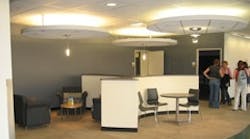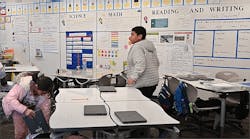For more than a decade, educators and designers have been moving tentatively into uncharted waters. They gradually are adopting new design principles that forsake the familiar practice of designing space by the numbers.
The use of mathematical formulas to determine an “appropriate” amount of classroom square footage per student is outdated and ineffective. Yet, designing space based on head counts and the effects that approach has on learning still can be found on most campuses. Utilization rates continue to drive most funding decisions.
Purchases of furniture and other equipment still are based mostly on traditional teaching styles — a simple desk, lectern and rows of tablet armchairs remain the classroom standard. Libraries still are filled mostly with sturdy oak tables and chairs ready to stand and serve for decades.
These old practices slowly are giving way to new ideas on space design that can enhance student success. Administrators, faculty and planners now recognize that learning spaces should be developed for reasons beyond utilization numbers. With declining retention and graduation rates, education institutions are acknowledging the importance of creating spaces that appeal to students and foster learning.
Designing as an art form
If mathematical formulas no longer are adequate for allocating and designing space, what criteria should replace them? How should planners determine size, configuration, shape and capacity of educational spaces to support student success? How can space be designed and furnished with learning as the goal? The answers are both simple and difficult.
The simple answer is to use learning theory as the basis for design. The difficulty is that studies have only begun to assess the relationship between space and learning. Until more thorough information is available, reasonable assumptions can be made about the effect space and its design have on education environments. These ideas can be gathered by simply observing the activities within newer models of learning environments.
Additionally, educators have identified certain factors that contribute to student success. As measured by the National Survey of Student Engagement Clusters of Effective Educational Practice, colleges and universities whose students perform well adhere to principles such as active and collaborative learning, student interaction with faculty members and a supportive campus environment. In light of these categories, it is easy to see why the practice of “x number of students per square foot” is falling out of favor as a guide for designing educational space.
Learning everywhere
A number of institutions are transitioning into space design based on achieving educational outcomes. Under this approach, administrators should consider all campus areas as potential spaces for learning. However, four primary learning places provide the best opportunities to achieve positive outcomes: the classroom, library, residence hall and hallway.
- The Classroom (Studio)
The spaces that are most effective for active and collaborative learning are those that create a flexible and fluid environment. A studio model, which resembles an open workspace for architects or artists, uses furniture such as movable tables and comfortable chairs. This enables more interaction than the typical classroom and supports student engagement and movement.
The question remains: how does flexible space actually benefit learning? Are there any intangible factors that also contribute to student success in an active and collaborative learning environment? Again, while there is much to be done in terms of pure assessment of these spaces, some significant conclusions can be drawn based on observations and anecdotes.
Primarily, furniture's ability to provide motion and to support different teaching configurations is important. The typical class structure begins with a short lecture or instruction followed by group activities, presentations and discussions. The ebb and flow of these activities requires that furniture be placed in several arrangements over a short period of time.
Furniture provides another important function. If it can be stacked or nested properly, it can quickly change the capacity of a room. For example, a room that normally serves 24 to 28 students could temporarily accept as many as 10 more if the furniture can be moved and stored against a wall. At other times just “getting it all out of the way” to completely open up the space works best.
These arrangements mean that the normal student count can be increased for special group discussions or other types of activities that are part of active and collaborative learning. Such flexibility also can satisfy institutions that insist upon headcounts to meet mandates.
In addition to flexibility, function is another essential design consideration in the learning environment. Students are central to the studio concept, and functionality should enhance their participation. They must have equal access to all aspects of the space and its supporting educational tools.
Keep in mind that designing for function has experienced a fundamental shift. Beyond mechanical systems, lighting and safety, it now stresses the importance of multiple sightlines and improved acoustics.
Furniture, too, can have an intangible influence on successful student outcomes. Well-designed environments with pleasing proportions, colors, textures and lighting can inspire learning.
By introducing color and texture within an otherwise neutral background, furniture can become an integral part of the studio aesthetic. Well-placed markerboards, whether mounted or movable, provide useful surfaces for recording and sharing information. Boards with figures and writings also serve as powerful visual elements that can focus and stimulate learners.
Another subtle influence proper furniture brings to learning is the ability to foster a feeling of well-being and security. Some students equate the ability to reconfigure furniture into individual settings with assuming ownership of the space. This promotes respect for the learning environment and encourages community, two other important aspects of learning.
- Hallways
When using the traditional approach to design, hallways are considered a necessary evil — a way to get from here to there. They never were considered to be spaces for learning, but were designed instead to meet the minimum size requirements allowed by code for “means of egress.”
Space that allows for feedback and interaction with faculty has proven important for effective learning, yet most hallways actually inhibit the flow of ideas. Hallway design should provide opportunities to continue the discussions and collaboration found in the studio environment.
Some newer projects are being creatively designed to use transitional spaces for learning. Indiana University-Purdue University, Indianapolis, took a wide corridor used primarily by students and held a competition with local designers and furniture suppliers. The result was a series of “nooks” that supported learning by providing tables, chairs, couches, markerboards, lighting and carpeting that transformed a once-dreary space into a vibrant area for learning.
- Libraries
Traditional furniture in the library is giving way to environments that support electronic research, group functions and interaction among students, library staff and faculty. Based on new concepts such as “learning commons” and “portal of knowledge,” libraries are recapturing their role as vital campus centers.
Much of this transformation is because of a greater degree of flexibility in these spaces. This primarily comes from better applications of technology and providing furniture appropriate for research and collaboration. Libraries increasingly use movable walls and other flexible furniture to create pods — natural places for students, staff and faculty to interact.
- Residence halls
Since the initial “Academical Village” concept that Thomas Jefferson conceived for the University of Virginia, student housing has lapsed into the conventional “dorm” definition. In what has been an essentially utilitarian living space, a resurgence of learning spaces within residence halls now is taking place.
Flexibility is the key to wise and efficient use of space in a residence hall. The ability to create, for example, an individual study space that can quickly morph into another use, such as a group study area, requires furniture that is mobile. Furniture, such as a comfortable chair and ottoman for setting books and laptops, also helps create an informal, relaxed atmosphere conducive to studying and discussions.
In addition, residence halls often are home to special events. Faculty presentations, guest lectures and student projects are the types of activities that can take place within a residence hall.
A holistic approach
As initial studies and surveys confirm the educational benefits of space design based on applied learning principles, education institutions will have compelling reasons to move in new directions and design physical space that supports student success. They should consider every square foot on campus as a potential learning space and explore ways to connect each area of learning. Furniture serves as the unifying element that carries through each space, helping to create a learning ecosystem in which students can achieve academic success.
Dittoe is a principal with Educational Facilities Consultants, LLC. Porter is vice president of education markets for KI, a manufacturer of furniture and wall system solutions based in Green Bay, Wis.
10
Additional number of people a typical classroom may be able to accept if the furniture is easily movable.




